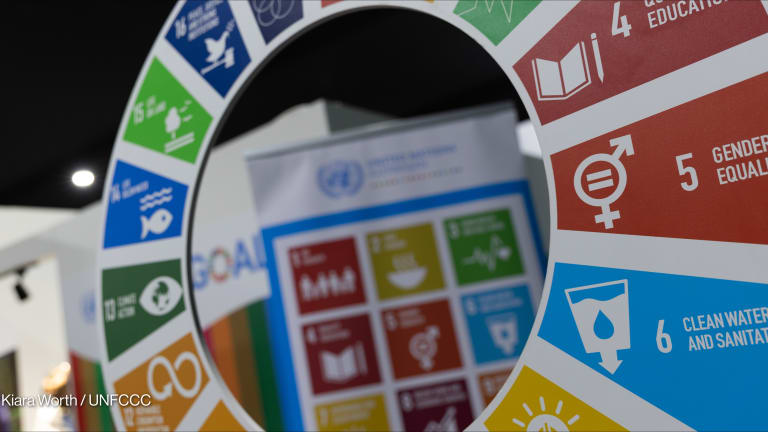Informal economy: ‘A nut that hadn’t yet been cracked’
The importance of the informal economy will perhaps figure more prominently in poverty-alleviation programs as the largely invisible but growing economy is set to flourish even further.
The informal economy, where those living in extreme poverty are concentrated, can be misunderstood and sometimes just overlooked by the development community. A regression analysis of International Labor Organization and International Monetary Fund data from 36 countries shows there is a link between high levels of informal employment and large percentages of populations in poverty, but there has been an incoherent approach in the poverty-reduction efforts that seek to target this particular sector. The importance of the informal economy will perhaps figure more prominently in poverty-alleviation programs as the largely invisible but growing economy is set to flourish even further: Figures from the U.N. Population Fund show that, by 2030, urban dwellers will number almost 5 billion and reside mostly in Africa and Asia. Much of this growth will be in the form of informal settlements contributing to a widening urban informal economy. The case of Haiti and Ghana Men and women alike are part of the informal economy, but it is women who tend to be relegated to the lower-skill and lower-income segments of this sector. “A common theme for most developing countries is that the majority of women living in extreme poverty work informally and that’s where the bulk of the income that they use to support their families comes from,” Elise Young, vice president of policy and government affairs at Women Thrive Worldwide, told Devex. In a recent report, Women Thrive Worldwide, which aims to improve the lives of women and families who live on less than $2 a day, took a closer look at the informal economies of Haiti and Ghana and delved into the challenges that women often face in these sectors. While the two countries are home to different economies, the exploitation of women within their informal economies is something they share in common. “In many developing countries, the informal economy is really the engine of a lot of economic growth. Yet, both men and women often experience exploitation within it,” Young said. “Women are even more likely to have their rights violated within informal work, though, as they have higher rates of illiteracy, have difficulty accessing local officials and are vulnerable to different forms of violence.” Mostly engaged in agriculture and under-the-radar trading, women in the informal economy in both Haiti and Ghana are vulnerable to predatory middlemen and creditors who can easily take advantage of their lack of education and connections. But unlike Haiti, which relies on food imports, Ghana has a more advanced network of markets and only has to import around 15 percent of its food. For women in Haiti’s informal economy, this means going on costly and sometimes even precarious trips across the border into the Dominican Republic just to buy food and sell them in Haiti. Meanwhile, women in Ghana — especially those in the northern part of the country, where poverty rivals that of Haiti — have their own hurdles to face in getting access to products in official markets. But in both Haiti and Ghana, the presence of women’s collectives helps low-income women save money, access capital, grow their own food and even put their children through school. “Collectives help both women and men — though especially women — find a place of value in an economy in which they often don’t have much power,” Young said. In Ghana, one such group is the Development Action Association, a group founded and run by a woman named Lydia Sasu. The collective, an association of rural farmers that aims to make its members self-reliant by expanding their access to education, land, infrastructure, technology and credit, is now in 54 communities with more than 2,000 members — 90 percent of them women. By partnering with DAA, Women Thrive Worldwide builds the group’s capacity and enables it to better voice its concerns. For instance, Young recounted how the group responded to illegal poaching, which robbed female fish processors of their livelihoods for years. “DAA got organized, translated Ghana’s national fishing laws into local languages, and lobbied the Ghanaian government to uphold those laws,” Young said. “After multiple visits by the women, the government had no choice but to act, and engaged the navy to help crack down on illegal fishing.” She acknowledged that Women Thrive Worldwide researchers thought that property rights were going to emerge as the main obstacle low-income women face, but they soon found out that this was “just one piece of a larger puzzle.” “Women kept telling us — and the existing research kept confirming — that the larger informal economy was a nut that hadn’t yet been cracked and needed urgent attention.” A need for better statistics and solutions In a 2011 paper for the International Institute for Environment and Development, researchers noted that the failure to comprehend the dynamics of the informal economy risks facing a false dilemma for the sustainable development agenda. This means having to ask questions like: “Does development entail eliminating the informal economy or working with it? Should it be suppressed or promoted, given its predominance?” The continued growth of the informal economy seems to render these questions irrelevant. Instead of looking to suppress the informal economy, governments and development partners have to focus on how to better target their efforts toward those working in this sector. “The ILO has the most comprehensive frameworks and policy recommendations for the informal economy, but even those are lacking in that they emphasize formalizing the informal sector rather than integrating it into a more complex and holistic economic system,” the Women Thrive Worldwide report noted. A better overview of the informal economy also requires good data. Unfortunately, a more comprehensive understanding of the informal economy is hampered by spotty statistics. Norms for data collection on the often-ignored sector have also only recently been established. The ILO and the research policy network called Women in Informal Employment: Globalizing and Organizing have already done some important work in this area, but a group effort among governments, donors, researchers, statisticians, policymakers, the private sector and civil society is also crucial to this effort. “Only a united data revolution will help turn the tides for a new era of measuring the informal economy,” Young said. The U.S. government, Young added, could lead the way on sex-disaggregated data analysis of the informal economy. The Quadrennial Diplomacy and Development Review, for example, could set the stage for this effort. Donors, of course, also have a role to play. There is currently little funding for general data collection, much less statistics on the informal economy. Investing in these systems could paint a better picture of the challenges that those working in the informal economy face — already a feat for such an opaque sector. This doesn’t mean that donors have been uninvolved in the informal economy. Donors have tried to ease the burden for those working in the informal economy by providing capital, seeds, credit, infrastructure and technical training. But while all these help, a combined inputs and capabilities approach would create “more sustainable gains,” according to Women Thrive Worldwide. For instance, women interviewed by the group emphasized that they would benefit from more soft skills — or the often-overlooked skills of negotiating, networking, public speaking and organizing. “They are the leadership skills that are rarely offered to women participating in development programs, but skills that can allow them to transform their lives and empower themselves forever,” Young said. Being able to organize in groups, which according to the women interviewed can end when funding for certain projects have stopped, would help women in the bottom rung of the informal economy increase their incomes as well. The women also expressed dissatisfaction with how donors have incorporated gender integration into their programs. Some governments and private donors, they said, initially expressed enthusiasm for gendered monitoring and evaluation, but later cut back on gender impact assessments because of the cost involved. “An approach to the informal sector should not target women per se, but take a careful gendered approach, understanding that gender norms deeply affect the informal economy,” the Women Thrive Worldwide report emphasized. Check out more insights and analysis provided to hundreds of Executive Members worldwide, and subscribe to the Development Insider to receive the latest news, trends and policies that influence your organization.
The informal economy, where those living in extreme poverty are concentrated, can be misunderstood and sometimes just overlooked by the development community.
A regression analysis of International Labor Organization and International Monetary Fund data from 36 countries shows there is a link between high levels of informal employment and large percentages of populations in poverty, but there has been an incoherent approach in the poverty-reduction efforts that seek to target this particular sector.
The importance of the informal economy will perhaps figure more prominently in poverty-alleviation programs as the largely invisible but growing economy is set to flourish even further: Figures from the U.N. Population Fund show that, by 2030, urban dwellers will number almost 5 billion and reside mostly in Africa and Asia. Much of this growth will be in the form of informal settlements contributing to a widening urban informal economy.
This story is forDevex Promembers
Unlock this story now with a 15-day free trial of Devex Pro.
With a Devex Pro subscription you'll get access to deeper analysis and exclusive insights from our reporters and analysts.
Start my free trialRequest a group subscription Printing articles to share with others is a breach of our terms and conditions and copyright policy. Please use the sharing options on the left side of the article. Devex Pro members may share up to 10 articles per month using the Pro share tool ( ).
Anna Patricia Valerio is a former Manila-based development analyst who focused on writing innovative, in-the-know content for senior executives in the international development community. Before joining Devex, Patricia wrote and edited business, technology and health stories for BusinessWorld, a Manila-based business newspaper.








